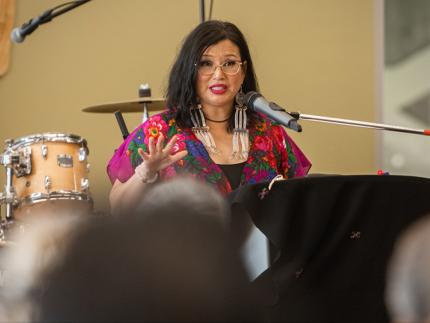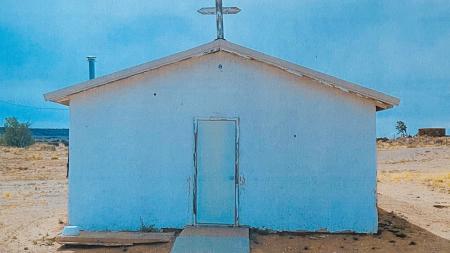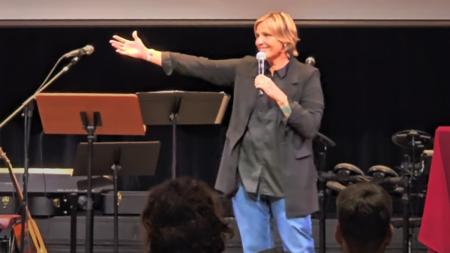Indigenous Matriarchs

Michelle Nieviadomy is Cree and a member of the Kawacatoose First Nation in Saskatchewan. She lives in Edmonton, Alta., where she works as assistant director at the Edmonton Native Healing Centre. She was asked to speak at the Canadian National Gathering about the topic of Indigenous matriarchs.
“The Indigenous woman is the most vulnerable woman here in Canada, and yet through [everything I’ve learned from Indigenous] teachings she is also the most powerful one,” Nieviadomy said. “Despite colonization and systems intended to eradicate her existence, her role, her leadership, her voice, she is still here.”
In Indigenous culture, matriarchs play an important role in the community. The Indigenous woman leads, heals, nurtures, teaches, and carries the torch of those who have walked before her. She is the one tasked with teaching younger generations and passing along traditions. She is also often the final decision-maker in community decisions.
“The word Iskwew in Cree means ‘woman.’ It is derived from the word Iskotew, which means ‘fire,’ which tells me that Creator knew what Creator did when he called woman into this side of heaven,” said Nieviadomy, explaining that women were given a fiery spirit and a duty to be a powerful presence in the world.
“She is the strength and backbone of her family and community,” said Nieviadomy. “And, let me tell you, she has birthed nations.”
Yet the vital role of women in Indigenous communities was destroyed by colonization. Residential schools, the Sixties Scoop, and other acts against Indigenous communities took children from their homes and ripped them from the women who could teach and love them. The patriarchy in Western society did not recognize or value the role that the woman played in Indigenous society, and racism further stripped her of her power, said Nieviadomy.
“Despite her irreplaceable contributions to the communities, [the Indigenous woman] was stifled. Our Canadian history tells the story in which the Indigenous woman faced layers and layers of barriers, discrimination, and exclusion, in which she could not be her authentic self. She could not be who Creator intended her to be with the policies that were in place, such as the Indian Act,” Nieviadomy explained.
But even in the face of discrimination, racism, colonialism, and sexism, the Indigenous woman is living proof of resilience, endurance, tenacity, and determination, she said. Nieviadomy then shared five stories of Indigenous women in Edmonton whom she sees as playing a vital role in ministry to their community today.
Trudy
Trudy is a Cree woman, elder, knowledge keeper, and pipe holder. She plants medicines in her backyard and even set up a huge tipi there as an example to others in the urban community.
In Cree culture, the tipi is the women’s lodge. Women are responsible for it, and even the design of the tipi is based on women. The wide base forms a circle to demonstrate the teachings of balance – mind, heart, body, and spirit, said Nieviadomy. The body of the tipi represents a woman’s dress, and the wind flags at the top are the woman’s arms and hands reaching up in thanks to Creator.
“It is a powerful visible representation of our culture,” said Nieviadomy.
Nieviadomy asked Trudy if she would come and sit on the sidewalks in one of the crime-ridden neighborhoods of Edmonton. She expected Trudy to say no, but instead Trudy accepted the offer. She arrived, set up a blanket on the sidewalk, and led a pipe ceremony right in front of a space where an unhoused person’s tent had burned the night before.
“Yes, people need a home, food, clothing, and water – but they also need spiritual care,” said Nieviadomy, “and Trudy showed up.”
She added that the residential school system took love from Indigenous people. “We were supposed to be surrounded by the teaching and love of our grandmothers and community, but, as we know, that was lost along the way,” she said. Through women like Trudy, the Indigenous community is calling that back.
Kokum - the Metis grandmother
Next, Nieviadomy shared a story that took place outside of the Edmonton Native Healing Center one cold morning. It was a Sunday morning, and there weren’t many places open, so people without houses were standing in the cold waiting to come inside. A kokum (grandmother) noticed a young girl who was waiting in bare feet.
“She used her strong and powerful voice and said, ‘Someone get this girl some shoes,’ and she had shoes on her feet within minutes,” Nieviadomy said. “That’s what grandmothers do.”
This Metis grandmother is dedicated to going to church every Sunday. She walks right through the dangerous parts of the neighborhood without fear.
“She is walking on the shoulders of matriarchs who walked before her. She knows who she is. She will tell the community to sharpen up, and the community respects her,” said Nieviadomy. “She attended residential schools. She is fragile in her age, but fierce in her spirit. She is a believer and a survivor. She will share her story with whoever will listen. “
Kokumlicious
Nieviadomy sees a similar fierce spirit in a woman whom she calls Kokumlicious. This woman is a mover and a shaker who works diligently behind the scenes in urban centers to advocate for what is fair and just for Indigenous communities.
“She sat at many decision- and policy-making tables quite aware that she was operating in a paternalistic system that goes against her understanding of her power as a woman, and yet she has remained. She has been able to adapt and adjust herself to the work culture. In some places it has been implied by her colleagues that she does not belong,” said Nieviadomy. “But she still powers through.”
Despite harassment, microaggressions, physical threats, and more, Kokumlicious remains faithful to her call, Nieviadomy said. “She stands in her faith in Creator that this is where she belongs.”
Elsie
When a prominent employer in Edmonton called Nieviadomy one day to ask for her advice on how to take the calls of the 2015 Truth and Reconciliation Commission more seriously, Nieviadomy told them, “Restore the matriarch, and restore the land.”
They went into action and created a position that is now filled by a matriarch named Elsie. Today Elsie has a role in executive leadership in that organization. She opens every meeting with prayer. She greets every child from the child welfare system who walks through the door, and she hugs them and says, “Welcome home.”
“When you know a matriarch, you know Creator’s love,” said Nieviadomy. “She is a reflection of Creator.”
Pauline
Though Pauline, a Cree woman, passed away four years ago, Nieviadomy has many fond memories of her. One of the most vivid of those memories, she said, has to do with a time when Nieviadomy felt called to go out into the bush and fast with other women. Nieviadomy said she is not a camper and was nervous about the experience, but still felt that she should participate.
“For our ceremony we will sit around the sacred fire all night – we pray, and we sing,” she said. On that particular night it started to rain as the women sat by the fire. When the sun came up, Nieviadomy was excited to get into her tent and out of the rain. Unfortunately she had forgotten to close the door on her tent the night before. Everything inside was wet.
Pauline came to check on her in the rain, and Nieviadomy vented about how wet she was inside her tent.
Two hours later Pauline returned. She had walked 20 minutes through the rain and mud to get back to where they had parked their cars. Then she walked the 20 minutes back and set up a bed for Nieviadomy to use.
“In that moment, I got it,” said Nieviadomy. “This is love. Creator sent me this grandmother to wrap her arms around me, take care of me, and nurture me. It is this kind of love that is going to call us to one another and call us back to the heart of Creator. We have a lot of loving to do.”


